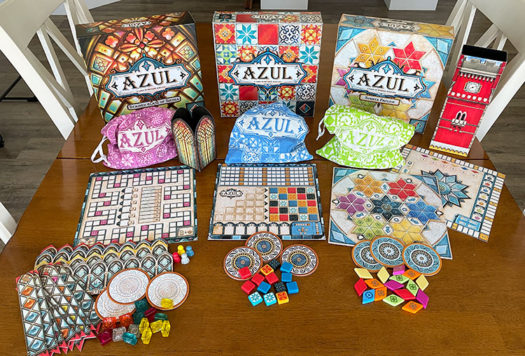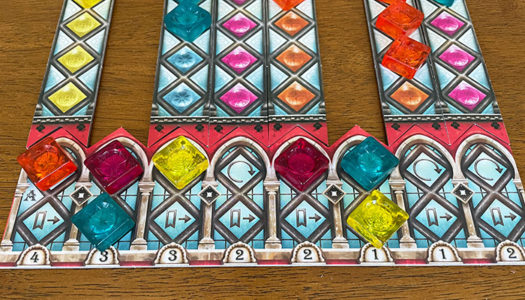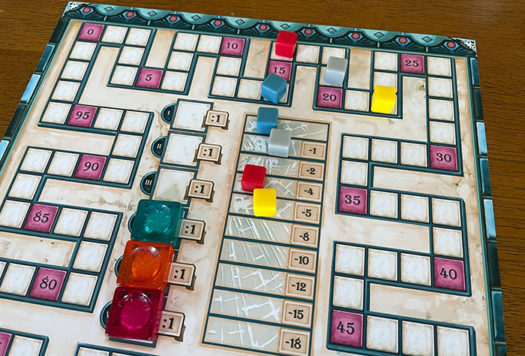3 Azul Board Games Compared

5 years ago, Next Move Games published a unique tile-laying game that made huge waves in the board game industry – Azul.
The game includes colorful and chunky tiles made of bakelite and it quickly jumped to the top of Hot Games lists all over the world. Because of its immediate success, it was very hard to find a copy of the game for months.
The main premise of the board game is that players are tile-laying artists who have been challenged to embellish the walls of a Portuguese Royal Palace in Evora. Players take turns drafting the tiles from the center to their player board. Once all tiles are taken, players score points based on how they’ve placed their tiles on the decorated palace walls (their own player boards).
Due to the game’s popularity, it was quickly followed by 2 additional Azul games in 2018 and 2019–each delivering familiar elements mixed with novelty. And today we’re reviewing and comparing each of these sequel games:
If you’d first like a rundown of the original Azul game, check out our original Azul game review.

Azul: Stained Glass of Sintra
As the name implies, the theme of Azul: Stained Glass of Sintra is that players are now constructing stained glass windows. As such the tiles are clear glass-looking tiles instead of solids colors like the original.
As with the original game, players draft their tiles from the center area and then place them on their own player boards. When drafting, players choose a color of glass tile from either a circular “factory” tile or the central area and take all of that color. If taken from a factory tile, the rest of the glass tiles are moved into the center ring. Then they place the taken glass tiles on their board.

Differences: Player Boards, Scoring, & Broken Glass
The big difference with Azul: Stained Glass of Sintra is what the player “boards” are like and how the tiles get placed.
In the original, each player had a single board where their collected tiles were placed in rows on the board. Then at the end of the round, one tile of that color from finished rows is slide into position to the mosaic on the right side of the board.
In Azul: Stained Glass of Sintra, player “boards” are comprised of single strips of boards with different color patterns on them. These are shuffled and randomly placed side by side above the player’s bottom board. Each player also has their “glazier” pawn above their glass window rows.

When a player collects glass tiles from the center, they must place them in matching color spaces in a window/column either directly below their glazier or to the right. If it’s to the right, the glazier is moved above that column.
Players also have the option of skipping taking tiles from the center and instead moving their glazier back above their left-most window column.

When taking and placing tiles, if a window column is filled, the player takes one of those tiles and moves it down to their bottom board. If it’s the first time for that column, it goes in the top space and the window tile is flipped over and replaced as part of their player board. If it’s the 2nd tile moved in that column, the window tile is removed from the game.
In either case, when a tile is moved to the bottom board, the player scores points. They get the point value listed in that column as well as points listed below the columns to the right that have either 1 or 2 tiles in them.

Also, when moving from a window pane to the bottom, if the window contains tiles of the color indicated for that round on the central board, the player scores bonus points. The player gets 1 points for each tile of that color in the window they just completed.
Another common element of the Azul games are “broken” tiles. These are penalties players get from having tiles that go unused. In this game, if a player takes more tiles than they can fit in their chosen window, for each “broken” tile, they move their marker down one space on the “broken glass” track. The points listed on this track will be subtracted from a player’s score at the end of the game.

A game round ends when all of the tiles are gone from the factory tiles and central area. If it’s not yet the final round, players refill the factory tiles and the player with the Start Player token begins the new round. At the end of the 6th round, the game ends.
Players score 1 point for every 3 glass tiles on their player board and lose the points indicated based on where their marker is on the broken glass track. Then they also gain end game bonus points based on how many of their glass tiles surround the special ornament icons on their board.
The player with the most points is the winner.
Azul: Summer Pavilion
Rather than decorating tiled walls or constructing stained glass windows, players are now constructing pavilions for the king. And instead of using square tiles, the tiles are diamond-shaped.
The same familiar tile drafting occurs in Azul: Summer Pavilion as in the previous games–namely that players take all of 1 color from a factory tile (moving all the colors not taken into the center) or from the central area. However, there are quite a few differences in Summer Pavilion that give players much more to think about.

Differences: No Immediate Placement, Wild colors, Saving, and Flowers
The first big difference is that players don’t immediately place the tiles they take onto their player boards. Instead, players simply place all the tiles they take during a round next to their player boards. Then, once all the tiles have been taken from the center, players take turns placing their tiles onto their boards.

Players take turns in placing their tiles at this stage mainly because they may place them in such a way that they get to claim bonus tiles from the central board along the way–which in turn gives them more tiles to place.
Also, each round one of the tile colors will be a Wild tile. Near the top of the central board, the 6 game rounds have a color shown above them. The round marker is placed on the color that is to be the Wild color for the round.
When a player drafts tiles from a factory tile or central area that also has at least 1 wild tile on it, they also get to take 1 wild tile with those they claim. And when placing tiles during the round, that color tile can be a substitute for any other color.
So how are tiles placed?
A player’s board has colored star shapes with numbers in each of the spaces. The colors indicate which color tiles may be placed there. The numbers indicate how many tiles of that color the player must posses before they can place a single tile in that space. The rest of the tiles are placed in the discard tower.

For example, to place a tile in the Green 4 diamond, I must have 4 green tiles (or a combination of green and the wild color). I would place 1 green tile on the diamond space and the other 3 will be discarded to the tower.
For the star in the center of a player’s board, there aren’t restrictions to where each colored tile may be placed, but all 6 tiles there must be different colors.
For each tile placed on their board, a player scores 1 point. In addition, if a tile is placed adjacent to another tile, the player receives 1 points for each of the connected tiles in that star.
If a player places a tile so that one of the special symbols is completely surrounded, the player gets the indicated bonus. These symbols are listed on the central board and let the player take 1, 2, or 3 tiles from the supply on the central board to immediately add to their stash.

At the end of a round, players may also choose to store up to 4 of their collected tiles for the next round. To do so, they place them in the diamond spaces in the corners of their player board. And excess tiles must be discarded to the tower and players lose 1 point for each of those “broken” tiles.
There’s also another way for tiles to “break” in Azul: Summer Pavilion.

The first player to take tiles from the center of the play area (not from the factory tiles) claims the Start Player marker. But they must also move their marker backwards on the score track a number of spaces equal to the amount of tiles they took that turn.
Like in Azul: Stained Glass of Sintra, Azul: Summer Pavilion ends after 6 rounds.
When the game ends, players check to see if they gain any end-game scoring bonuses. If they have completed any stars on their board, they’ll earn the points indicated on the central score board. Likewise, players will get bonuses for covering all of their 1’s, 2’s, 3’s, and 4’s on their board.
The player with the most points, wins the game.

Which Azul Game Do We Like Best?
Hopefully, our descriptions have given you a solid idea of how each of these Azul games differ in their style of game play.
As you can see, the central tile-drafting mechanism is the same in all of the Azul games. However, they differ in how those tiles are then placed and scored. And they differ enough to give each game its very own unique feel.
That’s why we plan to keep all 3 of these Azul games!
Which Azul game we choose to play will entirely depend on what type of mood we’re in and game style we feel like playing.
The original Azul game is very straightforward with players mainly focusing on which colors to draft and which row to place them in. Players can easily see their opponent’s boards and which tiles they may be after.
In Azul: Stained Glass of Sintra, there’s a lot more variability in each player’s board. The variable set up of the window panes and the need for players to move their glazier to the top of the row where they place tiles creates a more choices throughout the game. In addition, the option for a player to skip drafting tiles to move their glazier back to the left creates another layer of choice in the tile drafting itself that players must plan around. And if that’s not enough, the way players also score points for every column to the right of the window they fill brings in another element of strategic planning.
In Azul: Summer Pavilion, the amount of choices in the game ratchets up yet another notch. This game requires the most thinking of all of the Azul games. The combination of wild colors that change each round, star patterns with scores for placing adjacent, symbols to surround for taking bonus tiles, and storing up to 4 tiles for the next round means players can’t just float by in the game. They must actively plan every aspect of their turns based on what comes out on the factory tiles each round.
So when we’re thinking about playing Azul, it totally depends on how much complexity we want in our game night. If we’re in the mood to think through a lot of options and planning, we’ll grab Azul: Summer Pavilion. If we’re on the other end and want to play a quicker game but still enjoy some fun drafting choices, we’ll go with the original Azul game. And if we’re somewhere in the middle, we’ll go for Azul: Stained Glass of Sintra.
Which all means that when playing with my friends, we’ll tend towards Azul: Summer Pavilion.
And when playing with mom and the kids, Azul: Stained Glass of Sintra gets the vote most often. Yes, of all 3 Azul games, mom is going to pick this one every time!
Which will be your favorite Azul game?
They’re not stopping
Of course, with such popularity for each of the Azul games, don’t expect the Azul craze to end any time soon. As a case in point, last year, Next Move Games published a 4th Azul game–Azul: Queen’s Garden.
We haven’t had a chance to play it yet. When we do, we’ll post our review to share how it stacks up against these.






What a beautiful and comprehensive comparison of the Azul games! I also like all three games, but have a slight preference for ‘Azul Summer Pavilion’.